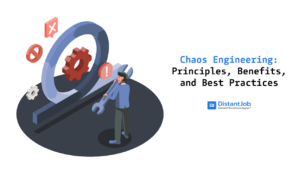Our planet is dying; embracing sustainable software development practices is one way the IT industry can contribute towards saving it.
Sustainable software development (or sustainable software engineering) is an approach to software design, implementation, and deployment that focuses on energy efficiency and environmental sustainability. It intends to minimize the impact software applications, architecture, and the infrastructure that hosts them have on the environment.
Below, we share some of the best practices for developing sustainable software applications and examples of how they can be incorporated into real-world projects.
How to Develop Sustainable Software: 9 Best Practices
Sustainable software development saves our planet, can reduce costs for businesses, enhances user experience, and provides a competitive advantage.
The following are guidelines for creating sustainable applications:
1. Define Your Sustainability Goals
The first step toward building sustainable software is to establish what sustainability means for your project and your metrics for measuring it.
Frameworks like Green Software Engineering Principles and Sustainable Development Goals (SDGs) can help you decide and ensure your software is industry-compliant and meets industry standards.
During the software development life cycle (SDLC) of your software, you should be able to predict its effect on the environment, society, and economy.
2. Adopt Agile and Lean Methodologies
Agile and lean methodologies focus on iterative development, waste reduction, and user feedback, which is perfect for sustainable software development. Kanban boards, retrospectives, and user stories are examples of Agile and Lean tools you may use to track and enhance the quality and function of your product.
3. Utilize Green Coding Practices
Green coding aims to minimize the energy involved in processing lines of code and, as a result, help organizations reduce energy consumption. Green coding practices include:
- Use of efficient algorithms: This can make a major difference in energy and resource consumption because efficient algorithms require less memory. Thus, it positively impacts performance and sustainability.
- Avoid redundant code: Developers can improve the maintainability and sustainability of software by avoiding redundant code.
- Use caching techniques: Storing data in a cache can prevent frequent data accesses, reducing computing time and decreasing energy consumption.
- Choose an efficient programming language: Green programming languages like C, C#, Go, Java, and Haskell are designed to optimize resource usage and minimize environmental impact.
- Reduce unnecessary dependencies: Software with too many dependencies becomes complex and requires a lot of energy and resources. Removing unnecessary dependencies can make the software leaner and more efficient.
- Continuous testing: Test your project components at different development stages to identify elements that require a lot of resources.
Implementing green coding can help you develop software that is not only sustainable but also more cost-effective in the long run.
4. Optimize Resource Usage and Minimize Waste
Sustainable software development aims to minimize resource usage and reduce waste throughout the software development lifecycle.
One way to use resources effectively is to optimize server and database operations, which can consume a large amount of energy. This can be accomplished using efficient algorithms, minimizing unnecessary queries, and implementing caching techniques.
Another way is to effectively use cloud services, which are scalable alternatives to traditional servers. Since cloud providers typically use energy-efficient infrastructures, developers can reduce energy consumption. It is, however, critical to ensure that only the necessary are used to avoid wastage.
Also, consider virtualization. With virtualization, you can run multiple virtual machines on one physical server. This way, your development team can reduce energy consumption since fewer physical servers are needed. Using container technologies like Docker also further improves energy efficiency and resource utilization.
5. Choose Appropriate Tools
The technologies you use can also impact the overall efficiency and sustainability of your projects. Choose tools that align with your sustainability goals, such as cloud-based services, low-power devices, and open-source software. Evaluate the trade-offs between different technologies, such as speed, reliability, scalability, and security.
6. Leverage Open Source Software
Open-source software can help companies save on licensing costs since they don’t have to pay for proprietary software. It allows developers to collaborate and share code, speeding up the development process and fostering innovation. For instance, developers can build upon existing, well-established, tested code instead of reinventing the wheel.
In addition, open-source software enables companies to customize and adapt code to their specific needs, enabling them to develop software faster and more efficiently.
7. Foster a Culture of Sustainability Within Your Team
To continue building sustainable software, you must get stakeholders on board. That means ensuring everyone understands the benefits of creating software products that positively impact the planet.
Provide training resources that give employees the knowledge and skills to develop sustainable software. This can be done through online training and workshops that teach best practices in sustainable software development, encouraging collaboration and innovation.
8. Integrate AI/ML
Artificial intelligence (AI) and machine learning (ML) can be used to automate and optimize processes, leading to more energy-efficient software solutions. By leveraging AI/ML algorithms, your development team can enhance applications to be more resource-efficient, reducing energy consumption and overall environmental impact.
These technologies can also help in predicting system failures, optimizing resource allocation, and improving overall system performance.
Integrating AI/ML into your software development process can lead to smarter, more sustainable applications that meet your business goals and environmental responsibilities.
9. Measure and Mitigate Carbon Footprint
Integrate software features that can monitor and minimize carbon emissions of applications and processes. For example, hardware utilization, electricity consumption, data distance, and data size are all carbon proxies.
Estimate and optimize cloud carbon emissions of websites or applications based on parameters such as Microsoft’s Cloud Sustainability Calculator or Google’s Carbon Footprint Dashboard.
Examples of Sustainable Software Development
Now that you know the green software engineering best practices, let’s consider some sustainable software development examples.
- Carbon-Neutral Websites: Websites designed to be hosted on servers powered by renewable energy sources or invested in carbon offset programs to compensate for the emissions produced.
- Energy-Efficient Algorithms: Developing algorithms that minimize computational resources and reduce energy consumption leads to more sustainable software products.
- Virtualization and Containerization: Utilizing virtual machines and containers to maximize server efficiency, reduce hardware needs, and optimize energy usage in data centers.
- Paperless Documentation: Embracing digital documentation and collaboration tools to reduce paper waste and promote a more eco-friendly work environment.
- Remote Work Solutions: Implementing software solutions that facilitate remote work to reduce the need for daily commuting, leading to lower carbon emissions and a more sustainable way of working.
Sustainable Software Development is a Continuous Effort
Sustainable software development is not a once-and-done task. It is a commitment to continuously reduce environmental impact by implementing eco-friendly practices into every phase of the development lifecycle. So, finding a framework that enables you to recreate and improve the process is crucial.
Use the tips above to kickstart your sustainable development journey and make a positive difference in the world.
If you are looking for eco-conscious software developers, we can help. We are DistantJob, an innovative recruitment company that connects tech talents with companies worldwide. We can help you build your dream team while contributing to a more sustainable future.
Contact us today to explore how we can work together toward achieving your sustainability goals.
FAQs
Sustainable software development focuses on creating applications that minimize negative environmental impacts. It achieves this by optimizing energy consumption, reducing waste, and promoting ethical practices throughout the software development lifecycle.
Five areas of sustainable software development include:
Caborn efficiency
Energy efficiency
Resource management
Hardware efficiency
Sustainability through measurements




